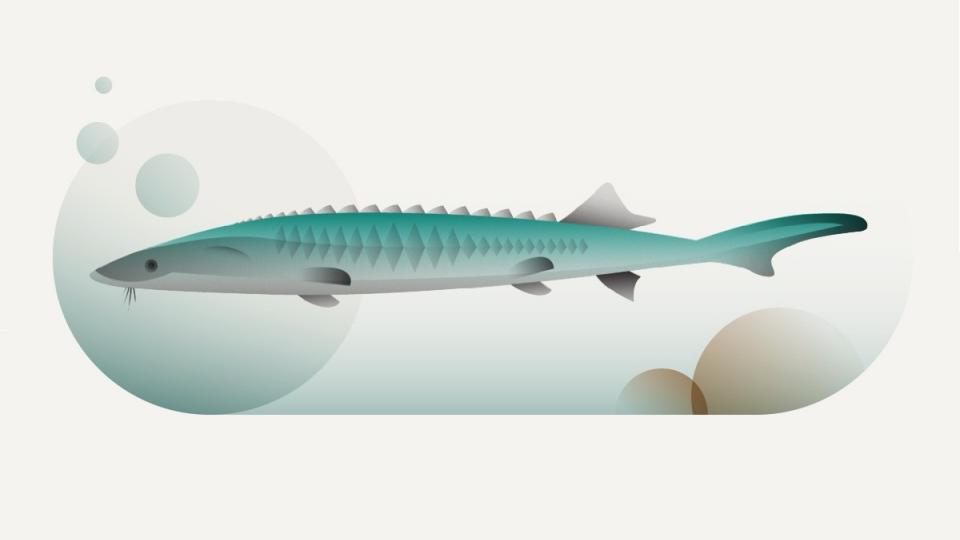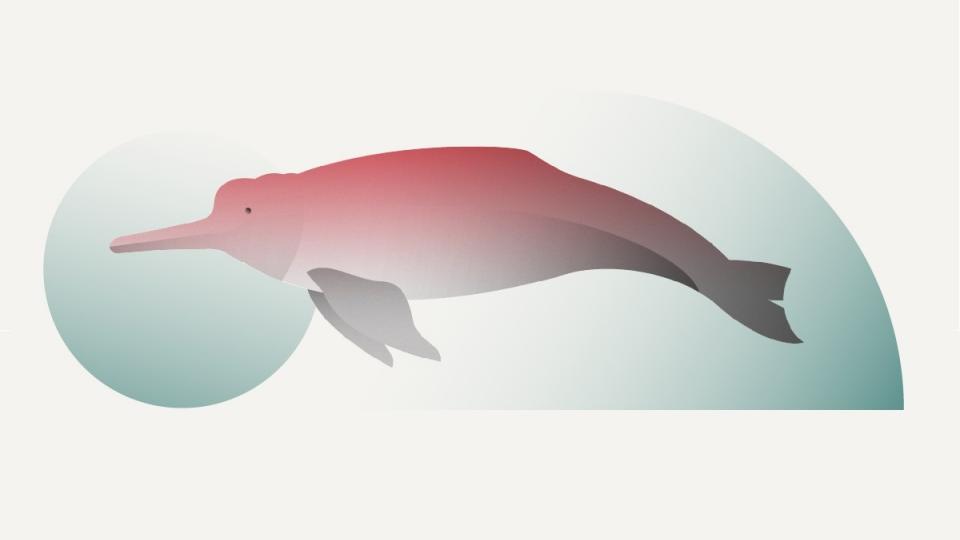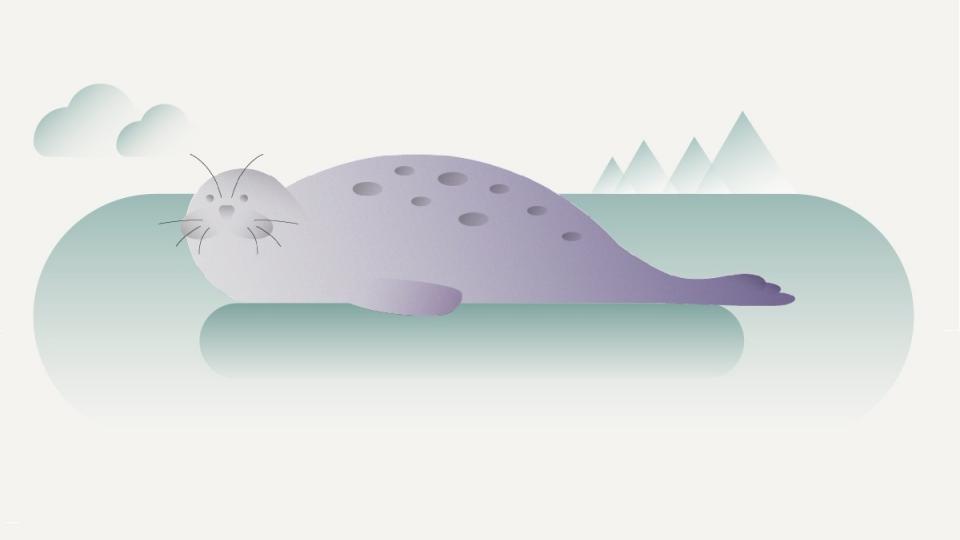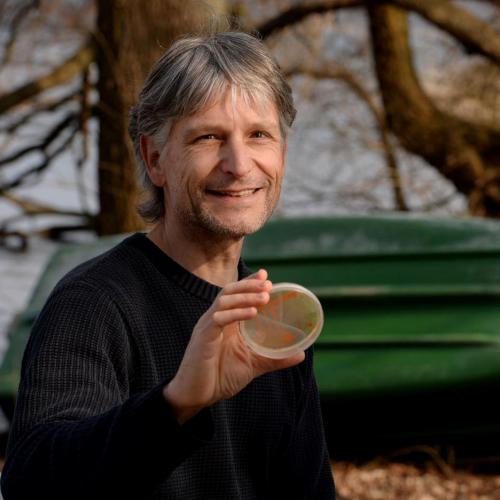
Populations of the freshwater pearl mussel (Margaritifera margaritifera) have declined by more than 90 per cent since the 1930s. One of the main causes is considered to be the siltation of river beds: the Holarctic species, which may grow up to 16 cm, needs stable cobble and gravel substrates with only small quantities of fine material. | Design by www.studioaden.berlin
Stressful influences such as climate change and a growing population are putting freshwaters all over the world under extreme pressure. As a result, the habitats of many species that are dependent on certain conditions for survival are diminishing. By contrast, adaptable species, some of which are invasive, are capable of spreading to new areas. What developments have been observed in recent decades, and how will these trends pan out? Is it possible to counteract these developments, and what action is expedient? IGB researchers are tackling these issues from various perspectives in a number of current projects. One thing for sure is that we must act if we are to preserve freshwater biodiversity throughout the world. After all, human life is also dependent on it.
The less oxygen there is, the less diverse life on earth gets
Long-term data on aspects such as water temperature or nutrient dynamics show changes in the past decades; such time series exist for many lakes around the world. IGB researchers were part of a team that analysed data that has been collected from almost 400 lakes since 1941, generating more than 45,000 oxygen and temperature profiles. Most of the long-term data originate from the temperate zone. The analysis shows that since 1980, oxygen levels in the lakes studied have declined by an average of 6 per cent at the surface and 19 per cent in the deep zone of thermally stratified waters. This means that lakes are losing oxygen around three to nine times faster than oceans. The temperature profiles also revealed significant changes: in 68 per cent of the lakes studied, habitats for many cold-water species are declining.
Taking Lake Stechlin as an example: “The oxygen-free zone at the deepest point of the lake has been steadily increasing for about a decade. As a result, the lake no longer provides a habitat for animals such as the endemic Stechlin cisco (Coregonus fontanae) at a depth below 40 metres in late autumn,” explained Hans-Peter Grossart. Other species native to Lake Stechlin are also suffering: fish need 60 to 70 per cent oxygen saturation in the water, and smaller aquatic organisms such as snails are also dependent on oxygen. At zero per cent, only microorganisms are able to survive in lakes.
In oxygen-depleted freshwaters such as Lake Stechlin, the problem is usually caused by inadequate mixing: the stratification phase, when the upper, oxygen-richer layer of a lake does not mix with the oxygen-deficient lower layer, has become more prolonged. Thermal stratification now occurs some two weeks earlier in spring and ends two weeks later in autumn. Several times in recent years, the dimictic Lake Stechlin has undergone intermixing only once instead of twice a year, i.e. it is then monomictic. Both phenomena result in significantly higher oxygen consumption rates in deep water layers, averaged over the year.
Permanent oxygen depletion in the deep zone unleashes a spiral effect: the more oxygen-deficient the lake bottom is, the more iron-bound phosphorus (P) is remobilised and released into the water, acting as an important nutrient for phytoplankton growth in the sunlit surface water after lake mixing. “This is referred to as internal eutrophication, i.e. self-fertilisation of the lake,” commented Hans-Peter Grossart. The more prolonged oxygen-free phases are, the more phosphorus is released from the lake bottom; the amount released then increases almost exponentially from year to year. The phosphorus released then stimulates increased algal biomass production the following year. This biomass sinks to the bottom of the lake and is then converted (“consumed” in part) by microorganisms; this conversion leads to a higher consumption of oxygen, which is then no longer available to higher organisms in the lake.
There are two main reasons why the mechanisms described above are at work, the first being global warming. Besides having the effect of less lake mixing, global warming causes a loss of oxygen. This is because oxygen saturation – the amount of oxygen that water can absorb – decreases when temperatures rise. The second reason is the increasing eutrophication of freshwaters due to human activities that result in wastewater discharges, nutrients from farming or waste materials from settlements being discharged into lakes.
“Lakes can be restored by using iron or aluminium salts to induce the precipitation of phosphorus during the algal growth phase, while at the same time covering the lake bottom to ensure that no additional phosphorus can be released and become available for algal growth,” stated Hans-Peter Grossart. But this is a complicated and expensive measure, especially when large lakes are involved. Researchers recognised the risk years ago, and issued warnings accordingly; in spring 2021, they additionally published their state of knowledge in an IGB Dossier.
Warmer water is problematic for cold-water species
Another team led by Ben Kraemer and Rita Adrian has also analysed long-term data from lakes worldwide. They focused on the long-term temperature changes in water. The researchers analysed data from 32 million temperature measurements from a total of 139 lakes, representing about 69 per cent of the Earth’s freshwater habitats by volume. They wanted to know how thermal habitats in lakes have already changed in response to climate change – whether they have shrunk or expanded. To this end, the researchers defined temperature habitat changes as the difference between current lake temperatures compared to before. Thermal habitat change was quantified as the percentage of thermal habitats that were lost or gained when comparing these two time periods.
They found that long-term temperature change resulted in an average 6 per cent difference between thermal habitats in the 1978-1995 and 1996-2013 periods. For selected species that are constrained by season and water depth, the thermal difference was as much as 19 per cent on average.
“Overall, warm thermal habitats tend to increase while cold ones decrease,” stated Rita Adrian. Species can cope with temperature increases by shifting to different depths or adapting their seasonal occurrence. However, these responses may be constrained by ecological interactions, life histories or limited resources. For example, cold-water fish species may not be capable of occupying deeper parts of lakes any more as oxygen concentration become insufficient - but at the same time cannot elude to upper water layers, where water temperatures are too high for them. They experience a double jeopardy of temperature and oxygen constraints at the expense of high metabolic costs. As a consequence, the southern distribution range of cold-water fish species has already shifted northwards.
Lakes in the tropics are particularly affected by the shift in thermal habitats: tropical lakes exhibit less variability in water temperatures than temperate lakes. If tropical lakes become warmer at the same rate, their thermal habitats are subject to even greater shifts. This has a marked negative impact on the species living there, which are often endemic. At the same time, changes in thermal habitat can result in the spread of invasive species. The round goby is an example of an invasive species that thrives in a range of temperatures and has spread explosively in waters where it is not native. Besides being able to affect the food web, water quality and species composition of the colonised ecosystem, invasive species can also promote the spread of diseases – invasive crayfish, for instance, transmit crayfish plague without actually contracting the disease.
Dams fragment river habitats
Diminishing habitats for large aquatic animals is the topic of a study led by Sonja Jähnig. More than 3,400 large hydropower plants with over one megawatt design capacity are either planned or under construction. The researchers investigated the global patterns of river connectivity within distribution ranges of freshwater megafauna and analysed how these patterns could change in the future. They found that the habitats of freshwater megafauna are particularly under threat from these construction projects. If all of the proposed dams are built, over 600 currently free-flowing rivers longer than 100 kilometres will be fragmented. More than 260 new dams would then fragment 75 major rivers such as the Amazon, Congo, Salween and Irrawaddy. Across the globe, 19 per cent of rivers longer than 500 kilometres where megafauna occurs would lose their free-flowing status. And yet the river systems affected are currently home to the highest biodiversity of megafauna – more than in the free-flowing rivers that would be left remaining or those that have already been fragmented.
Such dams block migration routes of freshwater megafauna and could lead to reduced reproduction and to genetic isolation. Freshwater megafauna often have complex habitat requirements and life histories adapted to the natural flow regime; many must move between habitats to complete their life cycles. Large fish species also migrate long distances to reproduce.
“Potential impacts on biodiversity, and especially on endangered and vulnerable species, must be taken into account in the planning of hydropower plants,” urged Sonja Jähnig. In summer 2021, she and five other IGB scientists drew up specific recommendations for sustainable water management in a Policy Brief aimed at federal policy-makers. In this document, the researchers criticise the “considerable implementation deficit”, and call for aspects such as the avoidance, reduction and realistic pricing of aquatic pollution, as well as the prioritisation of aquatic biodiversity protection as an interministerial objective.

The fragmentation of river systems is one of the reasons, alongside overfishing, that the European sturgeon (Acipenser sturio) is threatened with extinction. Obstacles such as dams are a challenge to many aquatic organisms. Migratory fish, however, are particularly strongly affected because they are no longer able to reach their spawning grounds. | Design by www.studioaden.berlin

The Eurasian beaver (Castor fiber) has experienced a sharp decline in its population and range in the past – to the point of extinction in many countries. But the species has now returned to many European regions. This success is due largely to conservation measures and reintroduction projects. | Design by www.studioaden.berlin

Populations of the Amazon river dolphin (Inia geoffrensis), which can grow up to a length of 250 cm, are dwindling, especially due to illegal hunting. This is compounded by fact that the animals get caught up in fishing nets, where they often die. Dams and other regulatory measures restrict their habitat. | Design by www.studioaden.berlin

The Baikal seal (Pusa sibirica) is the only seal species that lives exclusively in freshwater. Since the young are raised on the ice, the Baikal seal may be vulnerable to future climate change. | Design by www.studioaden.berlin







